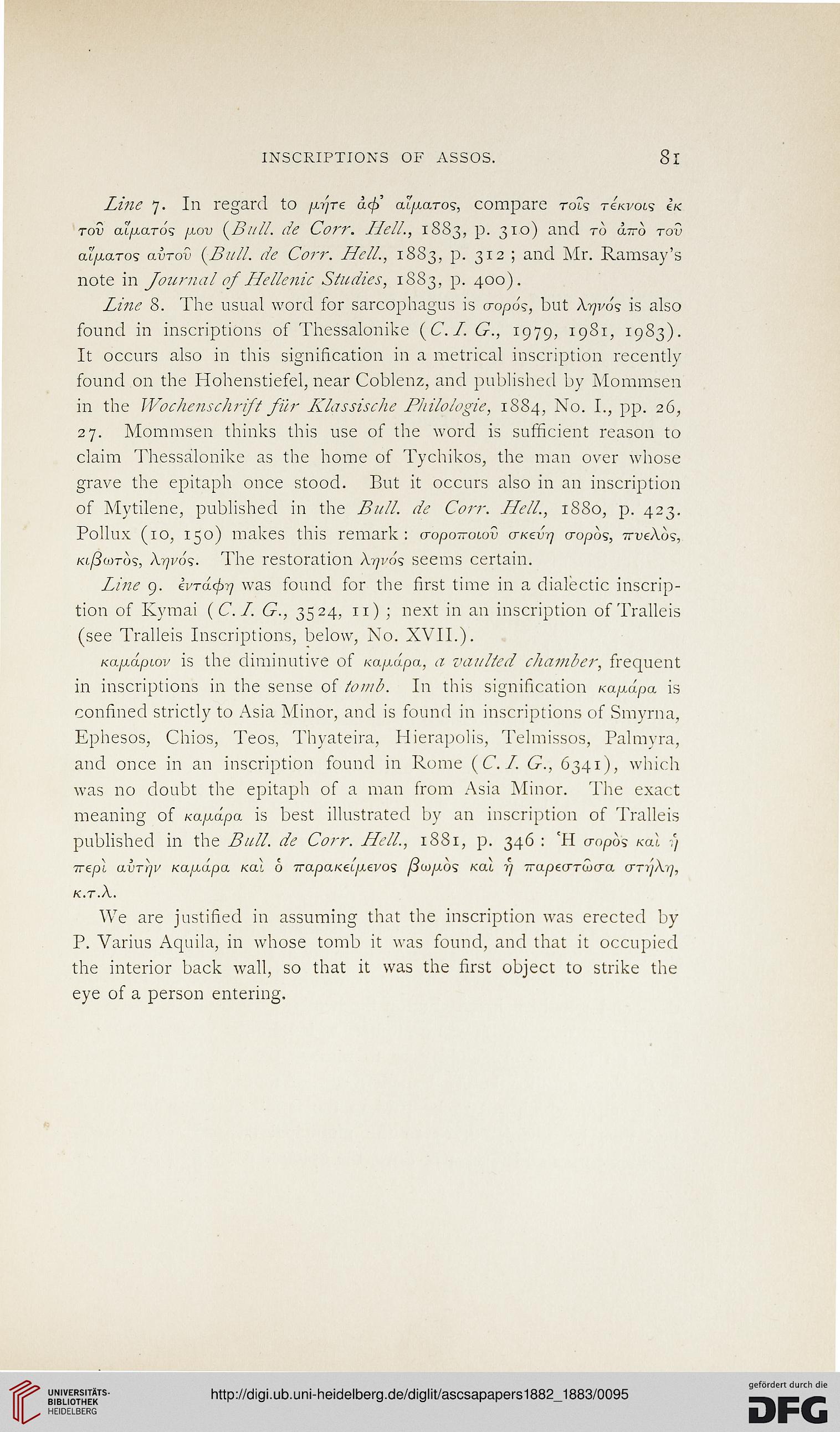INSCRIPTIONS OF ASSOS.
81
Line 7. In regard to pyre dc/>' aifjuvros, compare rot? tckvois
tot) at/xaros /xou {Bull, de Corr. Hell, 1883, p. 310) and to a.7ro row
at/xaTo? aurou {Bull, de Corr. Hell., 18S3, p. 312 ; and Mr. Ramsay's
note in Journal of Hellenic Studies, 1SS3, p. 400).
Line 8. The usual word for sarcophagus is aopo?, but Xyvos is also
found in inscriptions of Thessalonike {C.I. G., 1979, 19S1, 1983).
It occurs also in this signification in a metrical inscription recently
found on the Hohenstiefel, near Coblenz, and published by Mommsen
in the Wochenschrift fur Klqssische Philqlogie, 1884, No. L, pp. 26,
27. Mommsen thinks this use of the word is sufficient reason to
claim Thessalonike as the home of Tychikos, the man over whose
grave the epitaph once stood. But it occurs also in an inscription
of Mytilene, published in the Bull, de Corr. Hell., 1SS0, p. 423.
Pollux (10, 150) makes this remark: aopo—oLov aKevy o-opos, irveXu^,
ki0<dt6s, \r)vo<;. The restoration A^vos seems certain.
Line 9. ivrdefry was found for the first time in a dialectic inscrip-
tion of Kymai {C.I. G., 3524, 11) ; next in an inscription of Tralleis
(see Tralleis Inscriptions, below, No. XVII.).
KafidpLov is the diminutive of Kapdpa, a vaulted chamber, frequent
in inscriptions in the sense of tomb. In this signification Kapudpa is
confined strictly to Asia Minor, and is found in inscriptions of Smyrna,
Ephesos, Chios, Teos, Thyateira, Hierapolis, Telmissos, Palmyra,
and once in an inscription found in Rome {C.I. G., 6341), which
was no doubt the epitaph of a man from Asia Minor. The exact
meaning of /ca/xapa is best illustrated by an inscription of Tralleis
published in the Bull, de Corr. Hell, 1881, p. 346 : CH cropo's /cat -,7
7repl avrr/v Ka/xdpa »cai 6 TrapaKeip.evo'i fiuypbs koI rj 7rupeo~Tajcra crriyA.^,
K.t.X.
We are justified in assuming that the inscription was erected by
P. Varius Aquila, in whose tomb it was found, and that it occupied
the interior back wall, so that it was the first object to strike the
eye of a person entering.
81
Line 7. In regard to pyre dc/>' aifjuvros, compare rot? tckvois
tot) at/xaros /xou {Bull, de Corr. Hell, 1883, p. 310) and to a.7ro row
at/xaTo? aurou {Bull, de Corr. Hell., 18S3, p. 312 ; and Mr. Ramsay's
note in Journal of Hellenic Studies, 1SS3, p. 400).
Line 8. The usual word for sarcophagus is aopo?, but Xyvos is also
found in inscriptions of Thessalonike {C.I. G., 1979, 19S1, 1983).
It occurs also in this signification in a metrical inscription recently
found on the Hohenstiefel, near Coblenz, and published by Mommsen
in the Wochenschrift fur Klqssische Philqlogie, 1884, No. L, pp. 26,
27. Mommsen thinks this use of the word is sufficient reason to
claim Thessalonike as the home of Tychikos, the man over whose
grave the epitaph once stood. But it occurs also in an inscription
of Mytilene, published in the Bull, de Corr. Hell., 1SS0, p. 423.
Pollux (10, 150) makes this remark: aopo—oLov aKevy o-opos, irveXu^,
ki0<dt6s, \r)vo<;. The restoration A^vos seems certain.
Line 9. ivrdefry was found for the first time in a dialectic inscrip-
tion of Kymai {C.I. G., 3524, 11) ; next in an inscription of Tralleis
(see Tralleis Inscriptions, below, No. XVII.).
KafidpLov is the diminutive of Kapdpa, a vaulted chamber, frequent
in inscriptions in the sense of tomb. In this signification Kapudpa is
confined strictly to Asia Minor, and is found in inscriptions of Smyrna,
Ephesos, Chios, Teos, Thyateira, Hierapolis, Telmissos, Palmyra,
and once in an inscription found in Rome {C.I. G., 6341), which
was no doubt the epitaph of a man from Asia Minor. The exact
meaning of /ca/xapa is best illustrated by an inscription of Tralleis
published in the Bull, de Corr. Hell, 1881, p. 346 : CH cropo's /cat -,7
7repl avrr/v Ka/xdpa »cai 6 TrapaKeip.evo'i fiuypbs koI rj 7rupeo~Tajcra crriyA.^,
K.t.X.
We are justified in assuming that the inscription was erected by
P. Varius Aquila, in whose tomb it was found, and that it occupied
the interior back wall, so that it was the first object to strike the
eye of a person entering.




